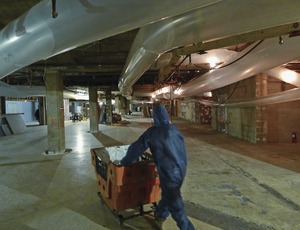

While New York City's 100-person Building Resiliency Task Force—convened in the wake of Superstorm Sandy—begins reviewing codes to recommend ways to make low-lying buildings more flood-resistant, building owners are reassessing their own storm protocols. At least one, Brookfield Office Properties, already has begun rebuilding the three flooded basements of its 50-story One New York Plaza.
The office tower sits near the southern tip of Manhattan. On Oct. 29, a 3-ft-high storm surge flooded three tower basements: a 30,000-sq-ft retail concourse, a garage and the central plant. Crews eventually pumped out 30 million gallons of water.
To make the tower more resilient, Brookfield will relocate the switch-gear equipment from the central plant up to the lobby. It also will move the building management system to a higher level, says Rich Bachia, a Brookfield senior vice president.
Though the basement levels have been gutted, propane-powered heaters, installed on the sidewalk and entrance plaza, are still drying out the 80,000 sq ft on three levels. The flexible piping, which spans over pedestrians' heads, resembles giant octopus arms as it disappears into the guts of the building. Currently, there is also temporary power for the three basements and the lobby.
The lobby, elevated several feet above the sidewalk, was untouched by the surge. Despite walls of sandbags as tall as five feet in front of the loading dock and three other at-grade entrances, the surge breached the basements. Water completely filled the spaces from floor to ceiling, stopping just three inches below the lobby, says Bachia.
The surge blew out the loading-dock doors, moving cars from the loading dock down the ramp to the garage level, he says. About 25 cars were affected, he adds.
Thanks to work-arounds using the 20th-floor mechanical room, the building re-opened on Nov. 17, exclusive of the basements. Brookfield currently is rebuilding the central plant, which is on the lowest level. The aim is to have it partly operational by mid-January and fully operational by mid-May. Brookfield is beginning to market new retail space.
At Millennium Tower Residences, a 36-story condominium in nearby Battery Park City (BPC), flooding also was limited to the basement, but only to the lowest level. That was thanks to quick thinking during the storm, when water outside the building was three feet deep.
In preparation for Sandy, building personnel used sandbags and tarps to protect the three entrances, two of which were at grade, and any areas below grade prone to flooding. But water coming from West Street, to the east—rather than from the Hudson River, to the west—penetrated beneath the sandbags and started to flood the two entrance vestibules at grade.
Damage would have been much worse had building personnel not ingeniously removed covers from the building's heat-pump system's ductwork. The improvised system funneled water to the lowest basement, which acted as a collection tank. There, pumps from the building's blackwater treatment system ejected the water to the street.


Post a comment to this article
Report Abusive Comment